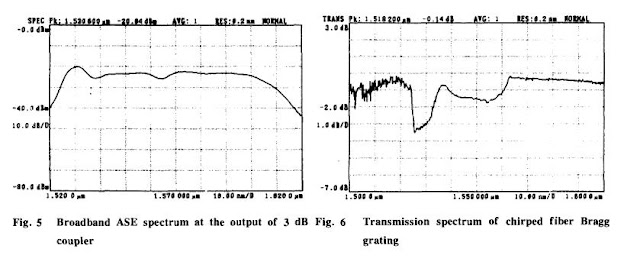A Double-pass Erbium-doped Fiber Based Broadband ASE Source by Utilizing C-band ASE Compensation
Abstract: A two-stage broadband erbium-doped fiber based amplified spontaneous emission (ASE) source is presented. By using double pass configuration and recycling backward C band ASE, the pump power for L_band ASE generation is much economized. With achirped fiber Bragg grating (CFBG ) as spectrum equalizer, a flat spectral bandwidth of 76nm is realized.
Introduction
Incoherent amplified spontaneouse mission (ASE) source with low spectral ripple sare widely applied in various are as such as optical device characterization, optical sensor systems, spectrum sliced dense wavelength division multiplexing (DWDM) systems, fiber-optical gyroscopes and low-coherence tomography. Erbium-doped fiber(EDF) based ASE source sare optimal choice to realize simuha- neous C-band and L-band operation. Nevertheless, since L-band is far away from the gain peak (1530nm ) of sillca-base EDF, the gain coefficient in L-band is much lower than thatin C-band (approxim ate-1vbyafactorof1O). Thus higher pump power and longer EDF are usually needed to enhance the power levelin L-band, leading to highercost of broadband sources.Various schemes of ASE sources have been reported in recent years, however, few of them are concerned about the aboveissue.
In thispaper.A novel structure ASE source operating in C plus L-band is demonstrated. By utiliz-
Ing double-pass and C-band ASE injection technique,the pump power for L-band output is highly econo-mized. With the presence of a chirped fiber Bragg grating (CFBG), the spectral bandwidth reaches 76nm with aspectral ripple of 2.8dB.
1 Experimental Setup
Fig.1 represents the schematic diagram of our two-stage broadband ASE source. In the first stage,
A 1480nm/1550nm wavelength division multiplexer(WDM) is utilized as the wavelength combiner and a 1480nm pump laser diode (LD) is used as the pump source. EDF1 is composed of about 18.4 m. erbium-doped fiber (absorption coefficient: 15.2dB/m at979nm; numerical aperture:0.22) with an other ~ 8m erbium-doped fiber (absorption coefficient: 4dB/m at979nm; numerical aperture:0. 21) to serve as the gain medium for an L-band ASE source. A fiber loop mirroris placed at the signal Dort of WDM to constitute the double-passcon figuration. The second stage of this broadband lightsource is a C-band ASE source that comprises about 20.4m EDF (absorptioncoefficient: 4dB/m at979nm: numericalaperture: 0.21 ) as the gain medium and a 980 nm LD as the pump source. Another section of ~ 30cm EDF (absorption coefficient: ~ 5.16dB/m at 980nm) is added to make the C-band ASE best flattened. An optical circulator (OC) is placed between the two stages to make the backward C-band ASE propagate back into the first stage,which will enhance the L-band ASE to a large extend. To ensure the continuity of the ASE spectrum between C and L-band,a 3dB coupler is utilized at the output end. Meanwhile, a CFBG also serves as the spectrum equalizerto provide a flat spectrum through out both C and L-band. Based on the above configuration,we have realized broadbandA SE output with improved pump efficiency.
2 Resuhsand Discussion
The shape and intensity ofC and L-bandASE can be regulated by tuning the 980 nm and 1480nm
LD simultaneously. When the C-band ASE generated from the second stage is cut off and 1480nm LD is set to 24.1mW, we monitored the L-band ASE spectrum with or without the Presence of fiber loop mirror (FLM ), as depicted in Fig.2 (a) and Fig.2 (b), respectively.
From Fig.2, it is obvious that the ASE intensity is much higher when FLM works. The L-band ASE power is measured at port 3 of the optical circulator and itturns to increase from 0. 11mW (without FLM ) to 0.17mW (with FLM ), showing that the ASE power has increased by approximately 54.5 indouble-pass structure.
Fig. 3 represents the L-band output spectrum with C-band ASE compensation when 980nm and
1480nm LD are set to 119.6mW and 24.1mW, respectively. Compared with the situation correspond- ingto Fig.2 (a) and (b), the L-band ASE increases to 2.11mW. Apparently, the C-band ASE injection plays an important role in the enhancement of L-band ASE. As C-band injection is paused, wead-just the L-band ASE spectrum by tuning power of 1480nm LD. When the L-band ASE comes to be nearly same as the previous spectrum as plotted in Fig.3 (see Fig.4), the power of 1480 nm LD increases to 61 mW .W e can clearly see that with the presence of C-band ASE compensation, the pump power for L-band generation is economize d by~60.5 %.
By adjusting the pump power, we precisely regulate the output ASE spectrum. When the power of 1480nm LD and 980 nm LD is set to 24.1mW and 119.6mW, respectively, optimal outcom e is obtained. Fig.5 represents the measured ASE spectrum at the output end of3dB coupler. From this figure, it is conspicuous that this ASE spectrum has a 65nm flat region from 1537.8nm to 1602.8nm and the spectral ripple is 3.6dB. In order to broaden the flat ASE bandwidth and decrease the ripple, a CFBG is utilized as the spectrum equalizer. The transmission spectrum of this CFBG is plotted in Fig. 6, Fig. 7 describes the broadband ASE spectrum after being flattened by the CFBG. With a ripple of 2.8 dB, the spectrum turns out to be flat from 1527.2nm to 1603.2nm and its output power reaches 2.38mW .
3 Conclusion
In conclusion, a novel structure broadband ASE source is proposed and demonstrated. By recycling C-band ASE, the pump power for L-band ASE generation is greatly economized. Moreover, the output ASE turns out a flat spectrum throughout 76nm with a ripple of no more than 2.8 dB. Such a broadband light source with flat spectrum and wide operation region will be of great significance for future applications in fiber optic systems.





Comments
Post a Comment